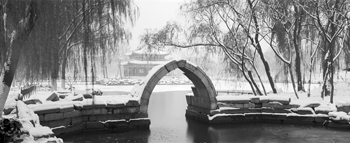|
|||||||||
|
FEATURESLois Conner: A Photographer in the Garden Lois Conner with her camera in Yuanming Yuan, spring 1998. Photo: GRB.  'Huabiao' at the western entrance of Peking University, moved from the Ancestral Temple (Hongci yonghu) at Yuanming Yuan. The New York-based landscape photographer Lois Conner has been working in China for over two decades. She first went to China in 1984 with a Guggenheim Fellowship to pursue her interest in the visual culture of that country and to explore through her own lens Chinese ways of seeing and ways of seeing China. She studied for a time at Peking University, where she acquired the rudiments of the spoken language, before going to spend months at Dunhuang recording the grotto caves for a major international project. While at Peking University she explored the city and began recording her understanding of it on film. In 1982, when she began working with a banquet camera with an elongated 7"x17" format, she examined the long handscroll paintings of traditional Chinese art to search for hints as to how these distended views reflected and shaped a unique perception of the land. It was during her time in Beijing in 1984 that Conner first made pictures at the remains of the Garden of Perfect Brightness. It was still not an often frequented public park, and it would still be some years before sections would be fenced off, surrounded by 'tiger skin walls' (hupiqiang and the grounds patrolled by security personnel. I first saw Lois's photographs when we met in New York in 1996. I had begun my own work on the garden and we arranged to meet in Beijing to begin making a 'portrait' of the gardens in 1998. Her work appeared in my lecture 'The Garden of Perfect Brightness, a life in ruins' (see the previous article in this section) long before we began investigating the dusty topography of despoliation that is the garden today. In 1998, and over the years since then, in all seasons and in all kinds of climactic conditions, we have visited the Garden of Perfect Brightness to make work there. On our visits we met and befriended Liu Jiwen, an amateur photographer who began making work in the garden in the 1970s. He now works in the administration of the gardens and, in recent years, he has kindly given us access to the original section of the Garden of Perfect Brightness that has undergone restitution and remains closed to the public. Due to the nature of the gardens, their reflection of cultural achievements and their political significance linking them to major southern centres in Zhejiang, Jiangsu and elsewhere, we have traveled far a field to pursue our work. In acknowledgement of our own travels to the south, I am including some images made outside the Yuanming Yuan here, and also in our joint work at the Imperial Mountain Villa at Chengde. Lois Conner's work on the Garden of Perfect Brightness has been the subject of an exhibition at the Sherman Galleries in Sydney in September 2001. She has produced a limited edition portfolio of some of the images she has made with me, which now number over three hundred. A large exhibition and related book on this collaborative project are in preparation. [GRB]
|




 Diptych of marble columns at Haiyan Tang, Western Pavilions
Diptych of marble columns at Haiyan Tang, Western Pavilions












